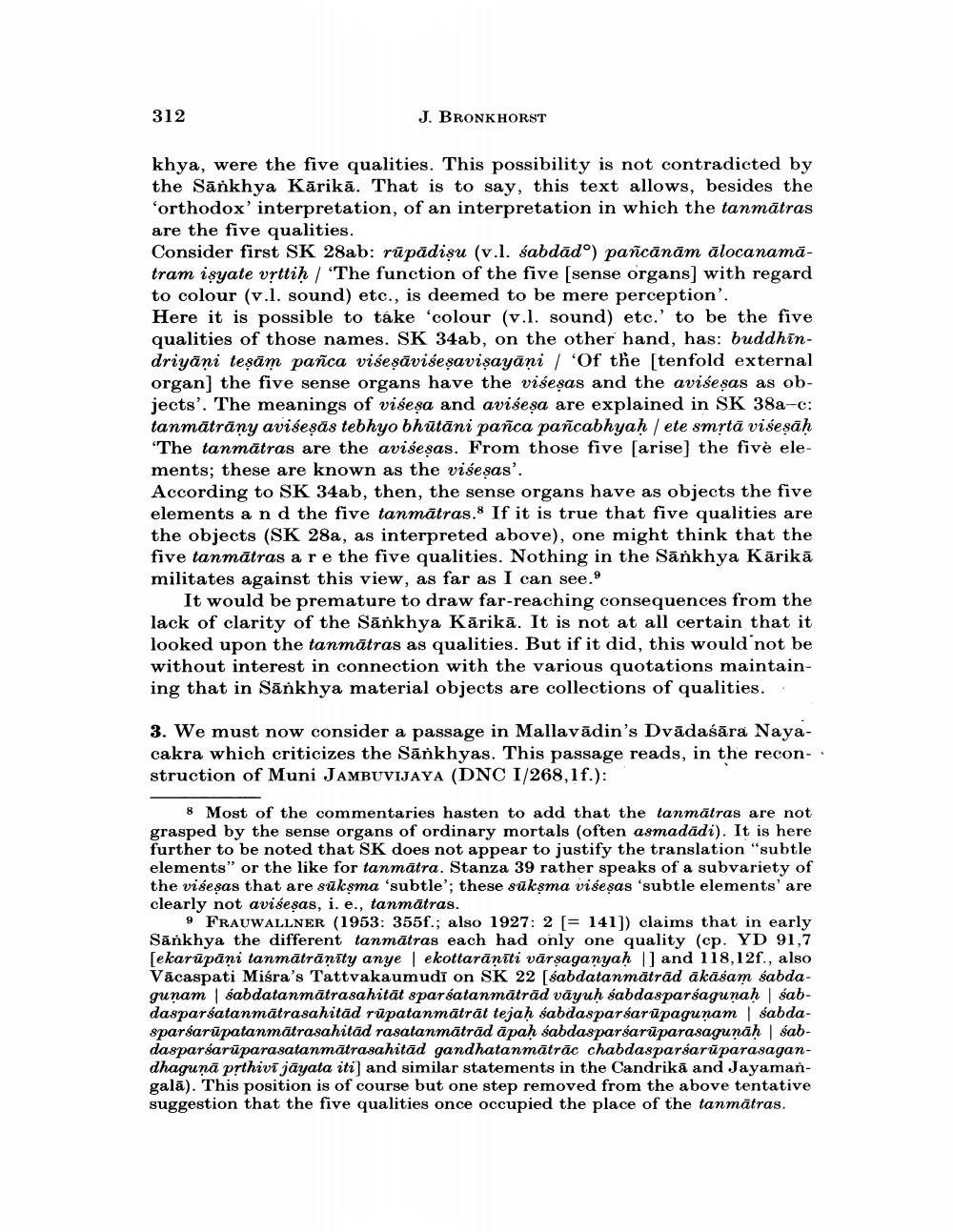________________
312
J. BRONKHORST
khya, were the five qualities. This possibility is not contradicted by the Sānkhya Kārikā. That is to say, this text allows, besides the 'orthodox' interpretation, of an interpretation in which the tanmātras are the five qualities. Consider first SK 28ab: rūpādisu (v.l. sabdado) pañcānām ālocanamatram isyate vrttih / 'The function of the five (sense organs] with regard to colour (v.l. sound) etc., is deemed to be mere perception'. Here it is possible to take colour (v.l. sound) etc.' to be the five qualities of those names. SK 34ab, on the other hand, has: buddhindriyāni teşām pañca viseşāvisesavisayāni / 'Of the [tenfold external organ] the five sense organs have the višesas and the avisesas as objects'. The meanings of visesa and avisesa are explained in SK 38a-c: tanmātrāny avisesās tebhyo bhūtāni pañca pañcabhyah / ete smrtā višeşāḥ "The tanmātras are the avisesas. From those five [arise] the five elements; these are known as the visesas'. According to SK 34ab, then, the sense organs have as objects the five elements and the five tanmātras. If it is true that five qualities are the objects (SK 28a, as interpreted above), one might think that the five tanmātras are the five qualities. Nothing in the Sānkhya Kārikā militates against this view, as far as I can see.
It would be premature to draw far-reaching consequences from the lack of clarity of the Sānkhya Kārikā. It is not at all certain that it looked upon the tanmātras as qualities. But if it did, this would not be without interest in connection with the various quotations maintaining that in Sānkhya material objects are collections of qualities..
3. We must now consider a passage in Mallavādin's Dvādaśāra Nayacakra which criticizes the Sānkhyas. This passage reads, in the reconstruction of Muni JAMBUVIJAYA (DNC I/268,1f.):
8 Most of the commentaries hasten to add that the tanmätras are not grasped by the sense organs of ordinary mortals (often asmadādi). It is here further to be noted that SK does not appear to justify the translation "subtle elements" or the like for tanmatra. Stanza 39 rather speaks of a subvariety of the visesas that are sūksma 'subtle'; these sūksma visesas 'subtle elements' are clearly not aviseşas, i. e., tanmatras.
9 FRAUWALLNER (1953: 355f.; also 1927: 2 = 141]) claims that in early Sankhya the different tanmātras each had only one quality (cp. YD 91,7 [ekarūpāni tanmātrānīty anye | ekottarānīti vārsaganyah 1] and 118,12f., also Vācaspati Misra's Tattvakaumudi on SK 22 [sabdatanmātrād akāśam sabdagunam sabdatanmātrasahitāt sparsatanmātrād vāyuh sabdasparsagunah sabdasparsatanmātrasahitād rūpatanmātrāt tejaḥ sabdasparsarūpagunam | sabdasparsarūpatanmātrasahitād rasatanmātrādāpah sabdasparsarūparasagunah sabdasparsarūparasatanmātrasahitād gandhatanmātrāc chabdasparsarūparasagandhagunā prthivi jāyata iti) and similar statements in the Candrikā and Jayamangalā). This position is of course but one step removed from the above tentative suggestion that the five qualities once occupied the place of the tanmātras.




